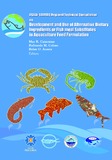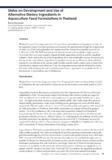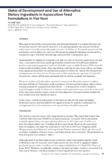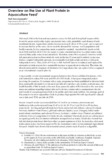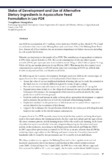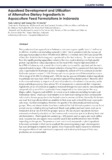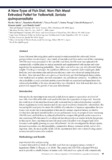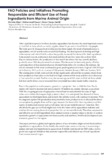Search
Now showing items 1-10 of 15
Development and use of alternative ingredients or fish meal substitutes in aquaculture feed formulation: Proceedings of the ASEAN Regional Technical Consultation on Development and Use of Alternative Dietary Ingredients or Fish Meal Substitutes in Aquaculture Feed Formulation
(Aquaculture Department, Southeast Asian Fisheries Development Center, 2015)
Recognizing the need for a concerted effort to follow-up on this priority issue of the ASEAN on aquaculture feed development and utilization. SEAFDEC (Aquaculture Department and Secretariat) and the Government of Myanmar ...
Status of development and use of alternative ingredients in aquaculture feed formulations in Singapore
(Aquaculture Department, Southeast Asian Fisheries Development Center, 2015)
The aquaculture industry in Singapore started in 1980s. The country has approximately 130 aquaculture farms, mostly located in the western part of the country. Aquaculture production mainly comes from coastal farms and the ...
Status on development and use of alternative dietary ingredients in aquaculture feed formulations in Thailand
(Aquaculture Department, Southeast Asian Fisheries Development Center, 2015)
Thailand is one of the major producers of aquaculture commodities and aquafeeds in Asia. As the aquafeed industry has been growing continuously, the government through the Department of Fisheries (DOF) had undertaken the ...
Status on development and use of alternative dietary ingredients in aquaculture feed formulations in Viet Nam
(Aquaculture Department, Southeast Asian Fisheries Development Center, 2015)
This paper reviewed fish catch production and estimated demand of aquafeed, fish meal, fish oil, soybean meal in Viet Nam for year 2013. Fish catch production was around 2.8 million metric tons (mt) while marine fish ...
Overview on the use of plant protein in aquaculture feed
(Aquaculture Department, Southeast Asian Fisheries Development Center, 2015)
Fish meal (FM) is the best and main protein source for fish and shrimp feed because of the favorable amino acid profile, highly unsaturated fatty acids, palatability and absence of antinutritional factors. Aquaculture ...
Status of development and use of alternative dietary ingredients in aquaculture feed formulation in Lao PDR
(Aquaculture Department, Southeast Asian Fisheries Development Center, 2015)
Lao PDR has a population of 5.7 million, with a land area 236,800 sq. km. About 87.7% of land or catchment areas drains into Mekong River and contributes 35% of the Mekong River Basin flow. Almost all of Laos territory has ...
Aquafeed development and utilization of alternative dietary ingredients in aquaculture feed formulations in Indonesia
(Aquaculture Department, Southeast Asian Fisheries Development Center, 2015)
Fish production from aquaculture in Indonesia continues to grow rapidly from 1.7 million mt in 2009 to 4.0 million mt (excluding seaweed) in 2013. This is consistent with the increase of total aqua feed production from ...
A new type of fish diet, non-fish meal extruded pellet for yellowtail, Seriola quinqueradiata
(Aquaculture Department, Southeast Asian Fisheries Development Center, 2015)
A non-fish meal diet using plant and/or animal protein materials for yellowtail, Seriola quinqueradiata was developed. Three kinds of non-fish meal diets and a control diet containing 50% fish meal were processed. In the ...
Processing of alternative feed ingredients in aquaculture feed
(Aquaculture Department, Southeast Asian Fisheries Development Center, 2015)
Fish meal and fish oil have been used worldwide in aquaculture feed formulations. Production of these ingredients has been relatively constant for decades. However, supplies of industrial fisheries are limited, and unlikely ...
FAO policies and initiatives promoting responsible and efficient use of feed ingredients from marine animal origin
(Aquaculture Department, Southeast Asian Fisheries Development Center, 2015)
After rapid development for three decades, aquaculture has become the most important source of food fish in Asia, which currently supplies about 55 per cent of food fish for the people. The rapid growth of aquaculture ...

